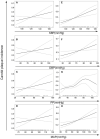The Role of Blood Pressure in Carotid Plaque Incidence: Interactions With Body Mass Index, Age, and Sex-Based on a 7-Years Cohort Study
- PMID: 34497532
- PMCID: PMC8420046
- DOI: 10.3389/fphys.2021.690094
The Role of Blood Pressure in Carotid Plaque Incidence: Interactions With Body Mass Index, Age, and Sex-Based on a 7-Years Cohort Study
Abstract
Background: Although high blood pressure (BP) is a risk factor for carotid plaque, its long-term prognostic value might be underestimated due to its confounding interactions with BMI, age, and gender. Therefore, we conducted a 7-year prospective cohort study to evaluate the prognostic value of BP for the incidence of carotid plaque. Methods: The subjects enrolled in 2011 were free of carotid plaque at baseline and were followed up in 2018. Multivariate Cox proportional-hazards models were used to evaluate the association between BP and carotid plaque incidence. Results: During the follow-up study, the incidence of carotid plaque was 36.5%. The significant positive linear trend showed that subjects with higher BP levels at baseline were more likely to develop carotid plaques at the end. Especially in the female subpopulation, after confounders being adjusted, the carotid plaque was associated with higher BP (adjusted HR 1.52, 95% CI 1.02-2.26), pulse pressure (PP) (adjusted HR 1.15, 95% CI 0.76-1.75), and mean arterial pressure (MAP) (adjusted HR 1.44, 95% CI 1.00-2.08). The adjusted HRs of hypertension, PP, and MAP (HR 27.71, 95% CI 2.27-338.64; HR 14.47, 95% CI 1.53-137.18; HR 9.97, 95% CI 1.29-77.28) were significantly higher after the potential antagonistic interactions between BP categorical indicators and age being adjusted, respectively. Conclusion: High BP indicators might be associated with higher HRs of carotid plaque after adjusting interactions between BP indicators and BMI, age, and gender, which suggests that the incidence of carotid plaque in female adults with high BP indicators might increase significantly with the increase of age.
Keywords: age; blood pressure; carotid arteries; cohort studies; interaction.
Copyright © 2021 Liu, Ma, Ren, Xiao, Yan, Li and Wang.
Conflict of interest statement
The authors declare that the research was conducted in the absence of any commercial or financial relationships that could be construed as a potential conflict of interest.
Figures


Similar articles
-
[Association between carotid artery plaques and all-cause mortality and cardiovascular events].Zhonghua Xin Xue Guan Bing Za Zhi. 2017 Dec 24;45(12):1086-1090. doi: 10.3760/cma.j.issn.0253-3758.2017.12.014. Zhonghua Xin Xue Guan Bing Za Zhi. 2017. PMID: 29325370 Chinese.
-
Pulse pressure amplification a mechanical biomarker of cardiovascular risk.J Am Coll Cardiol. 2010 Mar 9;55(10):1032-7. doi: 10.1016/j.jacc.2009.09.061. J Am Coll Cardiol. 2010. PMID: 20202520
-
Preoperative hypertension is associated with atherosclerotic intraplaque hemorrhage in patients undergoing carotid endarterectomy.Atherosclerosis. 2019 Nov;290:214-221. doi: 10.1016/j.atherosclerosis.2019.09.008. Epub 2019 Sep 22. Atherosclerosis. 2019. PMID: 31610883
-
[Body mass index and cancer incidence:a prospective cohort study in northern China].Zhonghua Liu Xing Bing Xue Za Zhi. 2014 Mar;35(3):231-6. Zhonghua Liu Xing Bing Xue Za Zhi. 2014. PMID: 24831616 Chinese.
-
An echolucent carotid artery intima-media complex is a new and independent predictor of mortality in an elderly male cohort.Atherosclerosis. 2009 Aug;205(2):486-91. doi: 10.1016/j.atherosclerosis.2009.01.032. Epub 2009 Feb 3. Atherosclerosis. 2009. PMID: 19243779
Cited by
-
Using Machine Learning to Predict Abnormal Carotid Intima-Media Thickness in Type 2 Diabetes.Diagnostics (Basel). 2023 May 23;13(11):1834. doi: 10.3390/diagnostics13111834. Diagnostics (Basel). 2023. PMID: 37296685 Free PMC article.
-
Pulse Pressure and Other Cardiovascular Risk Factors Associated with Multiple Carotid Plaques in a Rural Chinese Population: A Population-Based Cross-Sectional Study.Risk Manag Healthc Policy. 2025 Feb 25;18:617-628. doi: 10.2147/RMHP.S491001. eCollection 2025. Risk Manag Healthc Policy. 2025. PMID: 40027106 Free PMC article.
-
Vascular Aging and Atherosclerosis: A Perspective on Aging.Aging Dis. 2024 Mar 6;16(1):33-48. doi: 10.14336/AD.2024.0201-1. Online ahead of print. Aging Dis. 2024. PMID: 38502584 Free PMC article.
-
Causal relevance of different blood pressure traits on risk of cardiovascular diseases: GWAS and Mendelian randomisation in 100,000 Chinese adults.Nat Commun. 2024 Jul 24;15(1):6265. doi: 10.1038/s41467-024-50297-x. Nat Commun. 2024. PMID: 39048560 Free PMC article.
-
Metabolic score and its components are associated with carotid plaque prevalence in young adults.Endocrine. 2024 Nov;86(2):592-599. doi: 10.1007/s12020-024-03903-3. Epub 2024 Jun 7. Endocrine. 2024. PMID: 38849645
References
-
- China Hypertension Prevention and Control Guidelines Revision Committee (2019). Guidelines for the prevention and treatment of hypertension in China. Chin. J. Cardiol. Med. 24, 24–56. 10.3969/j.issn.1007-5410.2019.01.002 - DOI
LinkOut - more resources
Full Text Sources
Miscellaneous

